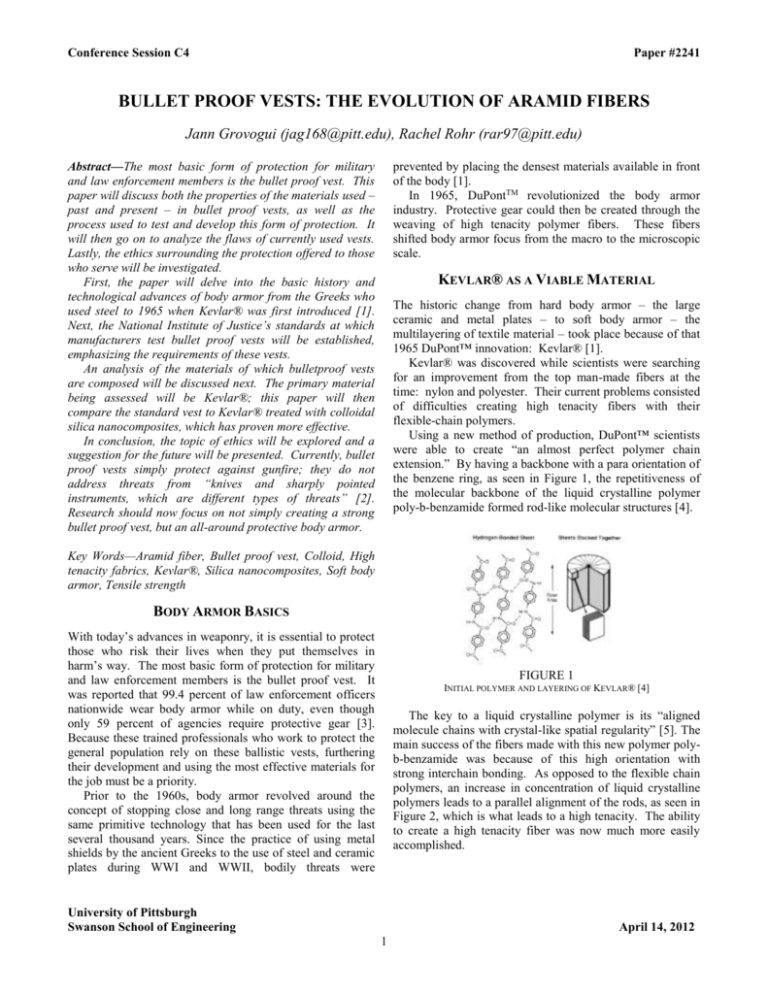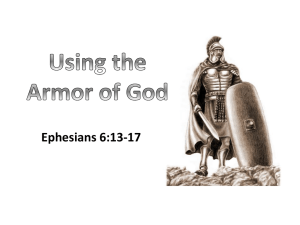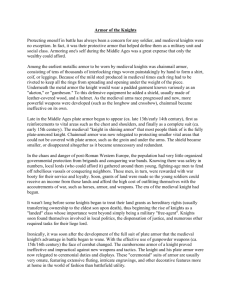
Conference Session C4
Paper #2241
BULLET PROOF VESTS: THE EVOLUTION OF ARAMID FIBERS
Jann Grovogui (jag168@pitt.edu), Rachel Rohr (rar97@pitt.edu)
Abstract—The most basic form of protection for military
and law enforcement members is the bullet proof vest. This
paper will discuss both the properties of the materials used –
past and present – in bullet proof vests, as well as the
process used to test and develop this form of protection. It
will then go on to analyze the flaws of currently used vests.
Lastly, the ethics surrounding the protection offered to those
who serve will be investigated.
First, the paper will delve into the basic history and
technological advances of body armor from the Greeks who
used steel to 1965 when Kevlar® was first introduced [1].
Next, the National Institute of Justice’s standards at which
manufacturers test bullet proof vests will be established,
emphasizing the requirements of these vests.
An analysis of the materials of which bulletproof vests
are composed will be discussed next. The primary material
being assessed will be Kevlar®; this paper will then
compare the standard vest to Kevlar® treated with colloidal
silica nanocomposites, which has proven more effective.
In conclusion, the topic of ethics will be explored and a
suggestion for the future will be presented. Currently, bullet
proof vests simply protect against gunfire; they do not
address threats from “knives and sharply pointed
instruments, which are different types of threats” [2].
Research should now focus on not simply creating a strong
bullet proof vest, but an all-around protective body armor.
prevented by placing the densest materials available in front
of the body [1].
In 1965, DuPontTM revolutionized the body armor
industry. Protective gear could then be created through the
weaving of high tenacity polymer fibers. These fibers
shifted body armor focus from the macro to the microscopic
scale.
KEVLAR® AS A VIABLE MATERIAL
The historic change from hard body armor – the large
ceramic and metal plates – to soft body armor – the
multilayering of textile material – took place because of that
1965 DuPont™ innovation: Kevlar® [1].
Kevlar® was discovered while scientists were searching
for an improvement from the top man-made fibers at the
time: nylon and polyester. Their current problems consisted
of difficulties creating high tenacity fibers with their
flexible-chain polymers.
Using a new method of production, DuPont™ scientists
were able to create “an almost perfect polymer chain
extension.” By having a backbone with a para orientation of
the benzene ring, as seen in Figure 1, the repetitiveness of
the molecular backbone of the liquid crystalline polymer
poly-b-benzamide formed rod-like molecular structures [4].
Key Words—Aramid fiber, Bullet proof vest, Colloid, High
tenacity fabrics, Kevlar®, Silica nanocomposites, Soft body
armor, Tensile strength
BODY ARMOR BASICS
With today’s advances in weaponry, it is essential to protect
those who risk their lives when they put themselves in
harm’s way. The most basic form of protection for military
and law enforcement members is the bullet proof vest. It
was reported that 99.4 percent of law enforcement officers
nationwide wear body armor while on duty, even though
only 59 percent of agencies require protective gear [3].
Because these trained professionals who work to protect the
general population rely on these ballistic vests, furthering
their development and using the most effective materials for
the job must be a priority.
Prior to the 1960s, body armor revolved around the
concept of stopping close and long range threats using the
same primitive technology that has been used for the last
several thousand years. Since the practice of using metal
shields by the ancient Greeks to the use of steel and ceramic
plates during WWI and WWII, bodily threats were
FIGURE 1
INITIAL POLYMER AND LAYERING OF KEVLAR® [4]
The key to a liquid crystalline polymer is its “aligned
molecule chains with crystal-like spatial regularity” [5]. The
main success of the fibers made with this new polymer polyb-benzamide was because of this high orientation with
strong interchain bonding. As opposed to the flexible chain
polymers, an increase in concentration of liquid crystalline
polymers leads to a parallel alignment of the rods, as seen in
Figure 2, which is what leads to a high tenacity. The ability
to create a high tenacity fiber was now much more easily
accomplished.
University of Pittsburgh
Swanson School of Engineering
April 14, 2012
1
Jann Grovogui
Rachel Rohr
protective that hard body armor. In fact, “Kevlar® fiber is
five times stronger than steel on an equal weight basis,
offering superior protection against fragmentation and
ballistic threats” [8].
DuPont™ currently stresses the fact that “there is no such
thing as completely ‘bullet proof’ armor,” and should instead
be more accurately described as “bullet-resistant” [9]. These
levels of resistance vary, and therefore not all vests can
provide the same protection. Through careful studies in
their Ballistic Labs in Virginia and Switzerland and as
established by the standards from the National Institute of
Justice, DuPont™ has discovered the various levels of their
materials which can best protect against specific bullet types.
Based on these varying levels of ballistic performance, the
National Institute of Justice has classified body armor into
five different types:
FIGURE 2
DIFFERENCE IN RIGIDITY BETWEEN PREVIOUSLY-USED
MAN-MADE FIBERS AND KEVLAR® [4]
Using the same technology which created their first high
tenacity polymer over the next few years, DuPont™ was
then able to develop a fiber of poly-paraphenylene
terephthalamide, as seen in Figure 3, which became their
high-strength aramid fiber seen today.
Type II-A protects against 9mm and .40 S&W caliber
bullets
Type II protects against 9 mm and .357 Magnum bullets
Type III-A protects against higher velocity 9 mm and
.44 Magnum bullets
Type III protects against rifles
Type IV protects against .30 caliber armor piercing
bullets [10]
By adjusting the layers of Kevlar in body armor as well
as the density, these different types can be created. This
variety is what allows men and women of different
professions to all use Kevlar® bullet proof vests. As they
enter different dangerous situations, they need the best
protection for what harm they will most likely face. Type IIA body armor is often used by police officers while Type III
is often used by military in tactical situations.
In addition, Kevlar® is so popular because of its light
weight and comfort. Law enforcement officers have relied
on Kevlar® for more than 30 years. For the same time,
every branch of the Armed forces has used Kevlar® vests.
FIGURE 3
POLY-PARAPHENYLENE TEREPHTHALAMIDE POLYMER [6]
Kevlar® and its aramid fibers, which can be seen in a
variety of places including the military, automobiles, and
fiber optics, is characterized by its unique properties which
include: high tensile strength at low weight, low electrical
conductivity, and flame resistance [4].
ADVANCING KEVLAR TECHNOLOGY
Since its development in the 1960’s there have been
numerous advancements made to improve the abilities of
Kevlar. Many more types of high tenacity fibers have been
developed such as Dyneema®,Twaron®, and several others
[11]. These new advancements have either enhanced the
strength to weight ratio of these individual fibers or
improved other qualities such as resistance to heat [12].
However, one of the most impressive advancements has not
been the development of a new fiber, but rather a way to
improve the properties of all high tenacity fibers. This new
technology involves the impregnation of colloidal silica into
the fibers of vests, also referred to as shear thickening liquid
[13].
A colloid is a “mixture in which a dispersed substance
(which is solute-like) is finely divided in a dispersing
Effectiveness in Bullet Proof Vests
By 1973, Kevlar® could be seen in bullet proof vest designs
for use in field trials. In 1976, a report was released which
concluded that this new soft body armor was effective and
ready for use [7].
Kevlar® so effectively “catches” a bullet because of its
woven multilayer fabric. Each layer works together to
engage a high-velocity projectile and attempt to stop it as
quickly as possible [4].
“The engaged fibers absorb and disperse the energy of
the impact, transferring it to other fibers at crossover points
in the weave of the body armor” [8]. The subsequent layers
absorb energy and reduce the force felt by the wearer.
Though labeled soft body armor, it by no means is less
2
Jann Grovogui
Rachel Rohr
medium (which is solvent-like)” [14]. A colloidal mixture is
any liquid that has with in it small spherical particles of radii
between 1nm and 1000nm [14]. Colloids are incorporated
into high tenacity fibers through a relatively short process,
which involved first the soaking of fabrics in a basin filled
with colloidal silica suspension. The material soaks for an
hour before then being removed from the colloid. Excess
liquid is then driven out of the fabric through a pressing
process and then finally the fabric is baked at 80°C for an
additional hour [11].
After this short process, the
transformation is complete and the strength of the fibers are
significantly improved.
the inter-fiber friction, causing there to be more dispersion
of forces.
In order to test this, of course, experiments had to be
performed. One such test was devised in order to test “neat”
fibers–fibers that were not impregnated with the colloid–
versus fibers treated with three different sized colloids (110
nm, 380nm, and 540nm) [11]. The tests that were performed
included but were not limited to; ballistic tests and string
pull tests.
Ballistic tests are the most obvious test that would occur
during testing of bullet proof vests. This involves the
launching of a projectile into woven fibers and examining
the impact the projectile has on them. In this experiment,
clay was also placed behind the woven fibers so that the
impact behind the cloth could be observed afterwards.
In addition to the ballistic test, a string pullout test was
performed. In an experiment like this, a machine is built to
pull out the string on the frayed edges of woven fibers. This
will test the inter-fiber friction which is usually a good
determinant of how well a certain woven fabric will disperse
a force put upon it. For a single string pull-out experiment
there are usually six factors that affect the result of the test.
These factors include: “…fabric style, material properties
such as elastic modulus and strength of the yarn, fabric
length, transverse load, surface treatment, and pull-out
loading rate” [16]. In the case of vests impregnated with
silica colloid, the colloid is the only difference between the
neat and treated vests is the surface treatment. Therefore any
difference in results will be due to the colloid because it is a
surface treatment of the vest.
FIGURE 4
Test Results
(ABOVE) UNTREATED KEVLAR® MICROSCOPY IMAGE
(BELOW) KEVLAR® TREATED WITH COLLOIDAL SILICA NANOCOMPOSITE
[15]
Due to the relatively new nature of shear thickening
technology, there are very few experiments that have been
performed. However, because of the potential of colloid
impregnated ballistic fibers, it is important for scientists to
continue their studies on this new technique in order to fully
test the qualities that this material possesses. Without such
research, it would be unethical to produce and use this
fantastic material in bullet proof vests without knowing if it
has certain flaws.
Bok-Won Lee, Il-Jin Kim, and Chun-Gon Kim performed
one experiment on the properties of silica colloid
impregnated fibers. In this experiment, two tests that were
performed were the string pullout and projectile tests.
In the projectile test, an interesting result was found.
Woven cloth treated with three colloid particle sizes were
tested (approximately 100nm, 300nm, and 500nm) along
with an untreated sample. These four fabric samples were
clamped by the team on each edge to a frame and clay was
used to back the samples in order to measure the back face
deformation of the fabric. When a 5.52-gram projectile was
launched at approximately 224 m/s at the fabrics, all the
fabrics except for the cloth impregnated with the 100 nm
colloid successfully arrested the projectile [11].
Despite the small size of the particles and the fact that
they are immersed in a liquid, this technology is surprisingly
effective and has incredible results. The first reason that this
technology is effective is that the addition of a liquid into the
fiber adds almost no weight or stiffness to the fabric [11]. In
addition, the stopping power is greatly improved. For
example, four layers of Kevlar® treated with 8 mL of
colloidal silica have the same strength properties as 14 layers
of dry Kevlar [15].
Shear Thickening Liquid Treatment
The basic reason that the fibers are significantly enhanced
when impregnated with silica is in part due to the mechanics
behind how bulletproof vests operate. The way that these
vests work is that when impacted by a bullet or other
projectile, the fibers within them interact with each other and
quickly disperse the concentrated force over a larger area of
the vest [16]. The theory behind why silica colloids improve
the stopping power of vests is that the colloid may improve
3
Jann Grovogui
Rachel Rohr
Another interesting finding from the results of this test
showed that in general, as particle size decreased, energy
dissipation increased; however, untreated cloth consistently
dissipated the least energy. The general reason that smaller
particles dissipate more energy is because there are more
particles with more surface area to interact, which in turn
causes more inter-fiber frictional force. Considering this
concept, it is bizarre that not only would the 100 nm
particles dissipate less energy than the 300nm and 500nm
particles, but it actually weakened the fibers because the
cloth was actually penetrated when impregnated by 100nm
particles but dissipated over 90% of the projectiles energy
when it was untreated [11].
This abnormality in this particular data proves that this
technology needs to be further researched. Because so few
studies have been done, it is unclear whether 100 nm
particles are too small to have any positive affect on aramid
fibers or if this data occurred because of an experimental
flaw. Perhaps there are more weaknesses of shear thickening
fluid that scientists are unaware of, and again this is why
aramid fiber technology needs to be researched in order for
us to be able to utilize this technology affectively.
Another interesting result occurred in the string pullout
test. As the strings were being pulled from the fabric, it was
found that at low speeds, all four fabrics that were tested
required nearly the same force to pull out the fibers.
However, as the speed of pullout increased, the colloids
begin to react to the speed. The special quality that shearthickening fluids such as this colloid have is that “during
normal use, they flow as easily as conventional liquids,” but
“when subjected to sudden stresses that make them flow at
higher shear rates, they instantly turn rigid and act like a
solid material” [13]. Because of this quality, there were
certain speeds of pullout that were revealed in which the
colloid switched from acting like a liquid to acting more
rigid and solid-like. In addition, the different sized colloids
reacted in this way at different speeds. For example,
between 400 and 500 mm/min the 300nm colloid reached its
shear thickening point and the resistance of the fiber it was
reinforcing greatly increased making it the toughest fibercolloid combination. However, at about 1356 mm/min the
100 nm colloid reached it shear thickening point and the
pullout force needed to pull the string increased by 89.2%
making it the toughest fiber-colloid combination at this point
[11]. This shows that different sized colloids may be more
effective for stopping projectiles at different speeds.
This knowledge is very important to ensure the safety of
those wearing vests. This is because that could mean that a
soldier protected by high velocity projectiles could be
injured by something more slow moving such as an arrow.
Because of intricacies such as this, more engineers need to
perform follow up experiments in order that shearthickening technology can be fully understood and utilized
in body armor. However, new aramid fiber technology is
not the only aspect of body armor that needs to be improved.
There are many factors that affect the durability and strength
of body armor and can cause significant degradation. These
factors cannot be controlled, but the need to create aramid
fibers that are more resistant to these outside factors is vital
for the full protection of those who use ballistic vests.
DOWNFALLS OF CURRENT BALLISTIC VESTS
Though ballistic vests have certainly achieved great
advancements since steel and ceramic plates during the two
World Wars, there are still many developments that need to
be made.
Ethically, these are issues that need to be focused upon
immediately. Men and women rely on these vests daily to
save their lives; research should therefore be done to make
them as effective as possible. A number of problems can be
addressed.
Environmental Effects on Vest Quality
Since wearers of bullet proof operate in all types of
environments, vests need to be able to withstand the variety
of elements these wearers face. Currently, Kevlar®, like all
materials, has points where it can no longer be as effective.
Providing the most protection at a neutral pH, Kevlar®
significantly reduces in strength when exposed to strong
acids and bases, as seen in Figure 5. It shows the break
strength–which prevents a sample from failing when
enduring loads–of Kevlar® remaining at different pHs [17].
FIGURE 5
EFFECT OF VARYING PHS ON KEVLAR® [4]
The U.S. Department of Justice and National Institute of
Justice report that temperature is also a worry with bullet
proof vests. Although Kevlar® degradation is mostly a
problem at extreme temperatures not faced on a daily basis,
the extended period of time which ballistic vests are worn
allows lower temperatures to be a problem as well. This is
mainly due to the fact that vests have such a long time to
endure such degradation; the typical life of a bullet proof
vest is three to five years [7]. As exposure to high
temperature continues, the tensile strength of a material,
which is “the maximum stress that a material can withstand
while being stretched or pulled before necking, which is
when the specimen's cross-section starts to significantly
contract,” is reduced [18].
4
Jann Grovogui
Rachel Rohr
Prolonged exposure to UV and visible light additionally
harms bullet proof vests; it can cause “loss of mechanical
properties, depending on wavelength, exposure time,
radiation intensity and product geometry” [4]. When the
absorption spectrum of Kevlar® is overlapped with the
sunlight spectrum, as shown in Figure 6, there is sufficient
energy to break the chemical bonds of the fiber and therefore
maximum degradation. For this reason, body armor should
never be dried outdoors, yet this cannot always be avoided.
The preliminary experiment described above lead to
further experiments and to another performed by the
National Institute of Standards and Technology. In this
follow up experiment, the aim was to discover if there would
be a dramatic degradation in aramid fiber strength when the
fibers were woven as is found in bullet proof vests. Another
aim was to discover why this effect was occurring, in order
to find a way to prevent this reduction in strength.
A machine was constructed that would apply a force
consistently that would replicate a folding in woven aramid
fibers. The machine ran fibers through either 5,500 cycles
or 80,000 cycles of folding, which is an amount not too
inconsistent with the estimate of folds stated earlier [20].
The results of this experiment showed that woven fibers
folded 5,500 times showed a strength reduction of 14% and
that those folded 80,000 times showed a strength reduction
of 41%. In addition, when externally examined through a
scanning electron microscope, no external damage was
observed. This leads to the conclusion that folding causes
internal damage of the fibers [20]. The internal damage that
was caused was predicted to be an increase in the internal
flaw density that all aramid fibers contain. These defects are
due to tiny “needle like internal voids having approximately
2.4 nm diameters and length of 30 nm which are connected
to each other through cracks or openings between micro
fibrils” [21]. Folding creates an increase in the flaw density,
which in turn causes a “higher probability of the fiber to
form a critical flaw big enough to fracture the fiber as the
tensile stress increases” [20].
FIGURE 6
UV AND VISIBLE LIGHT EFFECT ON KEVLAR® [4]
Day-to-Day Degradation
There are many factors, most of them being environmental,
that affect the strength of bullet proof vests. One factor that
is not environmental is the effect of folding on aramid fibers.
The specific type of folding in body armor that can cause its
degradation is the bending of the armor around joint areas
that occur due everyday movement. In fact, a simple
estimation is that “a body armor user might bend at the wait
(e.g., when entering or exiting a vehicle) 4 times per hour,
40 hours per week, 50 weeks per year, which would result in
8,000 folding cycles per year, or 40,000 folding cycles over
5 years” [19]. This estimate is consistent with the daily
activity that may be seen by a police officer; however this
may not be consistent with the amount of activity that an
active duty soldier would perform. In this case, a much
higher activity level would be observed, leading to more
movement and more eventual folding of body armor.
Because the movement cannot be measured accurately based
on a simple statistical analysis, the activity level of police
officers will be considered. Now that it is seen how many
times a piece of armor may be folded, it is safe to assume
that this factor cannot be ignored and that a way to
determine how much effect folding has on body armor but
be found.
One study was carried out by J.H. Kim, N.
Brandenburgh, W. McDonough, W. Blair, and G.A. Holmes,
in which 50 fibers of polybenzoxazole (PBO), a common
aramid fiber, were folded once each. Before and after each
fold, the single fibers were tested to find their strain-tofailure ratio. It was found that after just a single fold, there
was a reduction in the strain-to-failure ratio by 10% [20].
FIGURE 7
EVIDENCE FOR THE DECREASE OF TENSILE STRENGTH
AS CYCLES OF FOLDING INCREASE [15]
As a result, it can be seen that the folding of aramid fibers
through everyday use can cause a massive decrease in the
strength of ballistic vests. This is a flaw that has not been
overcome and is definitely one that should be looked into
further. According to the calculations made, it could be
possible for a vest to decrease in strength over the course of
10 years up to 41% and in the course of one year over 14%
simply to the everyday movement [20]. Of course, these
time estimates are based on the activity level of a police
officer. As stated earlier, in the case of an active duty
soldier, the level of activity would be much higher and thus
5
Jann Grovogui
Rachel Rohr
lead to a faster rate of body armor degradation, possibly
within the time of a single tour of duty, leading to much less
protection for those serving on the front lines. Because of
this great weakness in the properties of aramid fibers, it is
important for engineers to continue research and
development in order to not let body armor wearers enter
dangerous situations with the false assumptions that they are
protected.
In addition to problems with the material itself, a vital aspect
of body armor that needs to be reevaluated is a relatively
simple one: covering the body. Due to the need for
movement, ballistic vests cannot provide complete
protection. “In firearms assaults on officers, bullets may
strike in vital regions not protected by body armor, notably
the shoulder, underarm, and the gap between the front and
back armor panels. If a bullet strikes close to the edge of the
body armor panel, it can slide off the armor panel or backing
and penetrate the torso” [2]. Because parts of the body are
left exposed, multiple deaths occur each year even when
body armor is worn, most of which include gunshots to the
head or upper torso [7].
This separation forces wearers to choose one type of
protection over the other. Bullet proof vests, which are
characterized by superb protective abilities from gunfire,
“may not be completely effective against attack by a knife or
other sharp instrument, such as an ice pick” [7].
Unfortunately, bullet proof vests do not even protect against
all bullets, let alone these other dangers. Five types of bullet
proof vests exist because not one of these can protect against
all potential projectiles. Though police typically face lower
velocity 9mm bullets in their line of work (for which type IIA body armor is adequate), should a high-tense barricade
confrontation arise, their daily bulletproof vests will not be
suitable for the job. In these situations, “officers have died
from wounds received from weapons or ammunition
exceeding the rated protection of the armor” [10].
Leaving officers and other military personnel more
susceptible to blunt force trauma, stabbings, and other
projectiles for which their vests are not designed is therefore
a huge ethical issue. Every day, Chief of Police and
Commanding Officers send their men and women into
harm’s way partly unprotected. Not only should these men
and women understand that, but also developments should
be made in body armor to allow them as much protection as
possible.
Lack of Education
CONTINUING DEVELOPMENT
Since so many actions and environments could deteriorate
bullet proof vests, there is a strong need for users to be
educated about proper use. Though all vest companies
provide information about how to best maintain the quality
of their products, those using them often do not take careful
note [7].
For example, each model of armor has clear instruction
about how to clean the components. Inserts of body armor
should typically be cleaned with cold water and a sponge. If
soap is used, it must be removed completely, as it “prohibits
the accumulation of residual soap film, which can absorb
water and reduce the protective properties” [7].
Directions are also clear to say that body armor should be
regularly checked for signs wear; should the user choose to
ignore this step, they may be entering harmful situations
with potentially faulty defense.
As of January 2012, soft body armor has saved the lives of
more than 3,000 members of law enforcement alone since
the 1970’s, let alone the military personnel who use the same
body armor on a daily basis [22]. Soft body armor, which
was developed through the use of Kevlar®, is used by these
two groups because of its strength and comfort compared to
alternative body armor materials, especially much heavier,
less flexible hard body armor.
Since the development of the first aramid fiber in 1965,
numerous stronger fibers have been created such as
Dyneema® and Twaron® which have led to body armor
improvements [11]. However, developments cannot stop
there. More research into possible fiber enhancements needs
to be explored, such as the inclusion of sheer thickening
fluid into the woven fabrics.
Further, new research into maintaining the strength of
fibers in all environments should be completed, allowing for
maximum protection throughout a longer period of time.
Temperature resistance, ability to withstand all acidities,
endurance through exposure to UV and visible light, and
flexibility while maintaining strength are all areas which
need improvements.
Ultimately, body armor comes down to saving lives. “Of
the approximately 1,200 officers killed in the line of duty
since 1980, more than 30% could have been saved by body
armor” [4]. With continued developments, body armor can
save an even great number of people who risk their lives to
protect others.
Lack of Coverage
Protection Against Alternative Attacks
Possibly the most significant topic of education is
guaranteeing that ballistic vest users understand what exactly
their vests protect against.
Today, law enforcement and military troops face various
types of threats. Companies have created protective vests
for many of these; in addition to bullet proof vests, stab, bite,
and blunt force trauma vests all exist. The unfortunate
reality is that these all exist because no one vest can protect
against each of these threats.
6
Jann Grovogui
Rachel Rohr
id=66645616&titleid=3825&accname=University+of+Pittsburgh&checksu
m=541EBAA D94CCC9A1876600912982D6B9
[16] Hong, Ji Hye (July 22, 2011) “Yarn Pull-Out Behavior Under Dynamic
Loading”
UMI
Dissertaion
Publishing.
[Online].
Available:
http://proquest.umi.com/pqdlink?vinst=PROD&fmt=6&startpage=1&vnam
e=PQD&RQT=309&did=2517311471&scaling=FULL&vtype=PQD&rqt=
309&cfc=1&TS=1330270023&clientId=17454
[17] (2011). “Break Strength Testing.” AMETEK, Inc. [Online].
Available:
http://www.chatillon.com/test-solutions/test-types/breakstrength-testing.aspx
[18] (2010). “Capabilities.” S&P Heat Treating. [Online]. Available:
http://www.spheattreating.com/index-1.html
[19] Forster, Amanda L., Pierre Pintus, Guillaume H.R. Messin, Pintus,
Guillaume H.R. Messin, Michael A. Reilly, Sylvain Petit, Walter Rossiter,
Joannie Chin, Kirk D. Rice. (May 7, 2010) “Hydrolitic Stability of
Polybenzobisoxazole and Polyterephthalamide Body Armor” [Online].
Available: http://www.sciencedirect.com/science?_ob=MiamiImageURL&_
cid=271544&_user=10183724&_pii=S0141391010003952&_check=y&_or
igin=article&_zone=toolbar&_coverDate=28-Feb-2011&view=c&originCo
ntentFamily=serial&wchp=dGLbVlkzSkzk&md5=51edecc95d37c3671d78
3a46d 4c954f7/1-s2.0-S0141391010003952-main.pdf
[20] Holmes, Gale A., Jae-Hyun Kim, Derek L. Ho, Walter G. McDonough
(2010) “The Role of Folding in the Degradation of Ballistic Fibers”
Polymers Division, National Institute of Standards and Technology
[Online]. Available: http://onlinelibrary.wiley.com/doi/10.1002/pc.20870/
pdf
[21] T. Kitigawa, H. Murase, and K. Yabuki, J.Polym. (1998). Sci. Part B:
Polym. Phys., 36, 39.
[22] (2012). “Voluntary Ballistic-Resistant Armor Compliance Testing
Program.” Justice Technology Information Network. [Online]. Available:
http://www.justnet.org/Pages/bodyarmor.aspx
REFERENCES
[1] Kamenidis, Panagiotis. (May 2009). “Effect of Trapped Air on Heat
and Moisture Resistance of Multi-Layered Soft Body Armors.” Oklahoma
State University [Online]. Available: http://proquest.umi.com/pqdlink?
vinst=PROD&fmt=6&startpage=1&vname=PQD&RQT=309&did=178981
2731&scaling=FULL&vtype=PQD&rqt=309&cfc=1&TS=1326053089&cli
entId=17454
[2] (July 2008). “Ballistic Resistance of Body Armor.” National Institute
of Justice. [Online]. Available: https://www.ncjrs.gov/pdffiles1/nij/
223054.pdf
[3] (May 2010). “Body Armor.” The FBI Law Enforcement Bulletin.
[Online]. Available: http://go.galegroup.com/ps/i.do?id=GALE%7CA22
7073995&v=2.1&u=upitt_main&it=r&p=AONE&sw=w
[4] (2011). “Kevlar® Technical Guide.” DuPont. [Online]. Available:
http://www2.dupont.com/Kevlar/en_US/assets/downloads/Technical%20Gu
ide%20for%20KEVLAR_2011.pdf
[5] Wang, Xuefeng, Jonathan Engel, and Chang Liu. (2003). “Liquid
crystal polymer (LCP) for MEMS: processes and applications.” University
of Illinois. [Online]. Available:
http://www.mech.northwestern.edu/
medx/web/publications/papers/102.pdf
[6] (2006). “Kevlar®.” Engineering Library. [Online]. Available:
http://www.engineering.com/Library/ArticlesPage/tabid/85/articleType/Arti
cleView/articleId/91/KEVLAR.aspx
[7] (2001). “Selection and Application Guide to Personal Body Armor.”
National Institute of Justice. [Online]. Available: https://www.ncjrs.gov/
pdffiles1/nij/189633.pdf
[8] (2011). “Body Armor Facts.” DuPont. [Online]. Available:
http://www2.dupont.com/Kevlar/en_US/uses_apps/body_armor/about_body
_armor.html
[9] (2011). “Bulletproof Law Enforcement Body Armor.” DuPont.
[Online]. Available: http://www2.dupont.com/Kevlar/en_US/uses_apps/
body_armor/law_enforcement_body_armor.html
[10] “Body Armor Classifications.”
Global Security.
[Online].
http://www.globalsecurity.org/military/systems/ground/bodyarmor1.htm
[11] Lee, Bok-Won, Il-Jin Kim, and Chun-Gon Kim. (October 2009). “The
Influence of Particle Size of Silica on the Ballistic Performance of Fabrics
Impregnated with Silica Colloidal Suspension.” Journal of Composite
Materials. [Online]. Available: http://jcm.sagepub.com/content/43/2
3/2679.full.pdf+html
[12] Bourbigot, Serge, Xavier Flambard, Franck Poutch (February 2001)
“Study of the Thermal Degradation of High Performance Fibers—
Application to polybenzazole and P-Aramid Fibres” Elsevier: Polymer
Degredation
and
Stbility.
[Online].
Available:
http://www.sciencedirect.com/science?_ob=MiamiImageURL&_cid=27154
4&_user=10183724&_pii=S0141391001001598&_check=y&_origin=articl
e&_zone=toolbar&_coverDate=31-Dec2001&view=c&originContentFam
ily=serial&wchp=dGLzVlSzSkzS&md5=2c36e615df1277f7667685a17c83
5b93/1-s2.0-S0141391001001598-main.pdf
[13] Brown, Alan S. "Liquid armor stiffens when threatened." Mechanical
Engineering-CIME May 2006: 25. Academic OneFile. Web. 26 Feb. 2012.
[Online]. Available: http://go.galegroup.com/ps/i.do?id=GALE%7CA159
697092&v=2.1&u=upitt_main&it=r&p=AONE&sw=wupitt_main&it=r&p
=AONE&sw=w
[14] Tro, Nivaldo. (2011). Chemistry: A Molecular Approach. Upper
Saddle River, New Jersey: Pearson Prentice Hall. pp. 550 – 552.
[15] Li, X, H.L Cao, S. Gao, F.Y. Pan, L.Q. Weng, S. H. Song, and Y. D.
Huang. (April 2008). “Preparation of Body Armour Material of Kevlar
Fabric Treated with Colloidal Silica Nanocomposite.” Institute of Materials,
Minerals, and Mining. [Online] Available: http://docserver.ingentaconnect.
com/deliver/connect/maney/14658011/v37n5/s8.pdf?expires=1326338891&
ADDITIONAL SOURCES
Bacchus, Joe. (2006) “U.S. Army Research Laboratory in Aberdeen using
particles to stop bullets.” Dolan Media Newswires. [Online]. Available:
http://galenet.galegroup.com/servlet/BCRC?srchtp=adv&c=1&ste=31&tbst
=tsVS&tab=2&aca=nwmg&bConts=2&RNN=A148197353&docNum=A1
48197353&locID=upitt_main
(2012). “Aromatic Substitution Reactions.” Michigan State University.
[Online].
Available:
http://www2.chemistry.msu.edu/faculty/reusch
/virttxtjml/benzrx1.htm
(2011). “Kevlar® Reference Designs for Vests made with DuPont™
Kevlar®/Kevlar® XP™.”
DuPont.
[Online].
Available:
http://www2.dupont.com/Kevlar/en_US/assets/downloads/DSP_
KevlarXP_ReferenceDesigns_K23338.pdf
ACKNOWLEDGMENTS
We would like to thank Nick Andes for helping us to
develop our conference paper, as well as our Co-Chair
Caroline Repola. Also, thank you to Hans Mattingly for his
feedback throughout this process.
7







